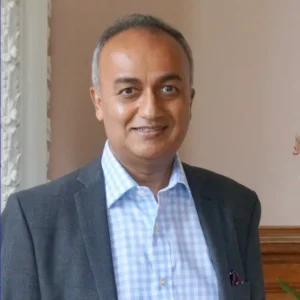
What is Focal Therapy for Prostate Cancer?
- Focal therapy targets only the cancer-affected areas of the prostate.
- It preserves more healthy tissue compared to traditional treatments.
- Focal therapy minimizes side effects like impotence and incontinence.
Our focal therapy treatment options
HIFU
High-intensity focused ultrasound (HIFU) is one of two types of focal therapy we offer. It uses ultrasound waves to target cancer in the lower, or posterior, part of your prostate. HIFU is a non-invasive treatment that is guided by advanced 3D MRI imaging to destroy cancer cells while protecting healthy tissues.- Soundwave-based treatment
- Preserves urinary and sexual function
- Day procedure and rapid recovery
NanoKnife
NanoKnife is the other type of focal therapy we offer and uses electrical pulses to target the upper, or anterior, part of your prostate. Guided by 3D MRI imaging, NanoKnife is a minimally-invasive treatment that destroys cancer cells that may be hard to reach with HIFU.- Needle-based treatment
- Preserves urinary and sexual function
- Day procedure and rapid recovery
Learn more about Focal Therapy
Meet our World Leading Clinical Specialists
“[Marc Laniado, my Focal Therapy Clinic consultant] described the possible side effects….and basically it was a no brainer to have the focal therapy because that obviously carried the least side effects and, because of the cancer, he said he felt that it would be very successful.”
Brian Bishop
The Focal Therapy Clinic patient
Is Focal Therapy right for me?
Focal therapy is usually only considered for localised prostate cancer. We can also only make a definitive judgement after we’ve reviewed your test results, include PSA level and MRI scan. Whether focal therapy is suitable for you and your cancer depends on a number of factors, but generally:
Early or intermediate stage
Gleason score of 7 or lower
Your prostate cancer is confined within the prostate gland
Our expert urologists will be able to guide you on your treatment options after your initial consultation. They will look at your PSA, your Grade/Gleason score and biopsy results. We will also independently review your mpMRI scan.
Check your suitability
At one year after one focal therapy treatment
*Based upon a review of 270 patients who all had treatment at The Focal Therapy Clinic using advanced MRI-ultrasound fusion technology to ensure treatment accuracy
Advantages and Disadvantages of Focal Therapy
Advantages
- Minimally invasive - No incisions, no radiation, no hormones
- Preserves sexual function & continence - spares nerves and urinary structures
- Outpatient procedure - Go home the same day. Rapid recovery
- Repeatable if needed - Can be combined with other treatments
- Effective cancer control - equivalent to radiotherapy or surgery at 8 years
Disadvantages
- Not suitable for all prostate cancers - Advanced cases may require other treatments
- Follow-up monitoring required - Regular PSA testing and MRI scans needed
- Risk of incomplete treatment at front of prostate - HIFU has a range of 3.0 cm from the rectum. Tumours at the front of the prostate care hard to reach
What to Expect Before, During, and After Treatment
What to Expect Before, During, and After Treatment – Hifu
- Pre-treatment imaging (MRI/ultrasound) to pinpoint the cancer
- Blood tests (PSA levels, general health)
- Discussion of anesthesia options (general or spinal)
- Bowel preparation (as advised by your medical team)
What are the side effects of Focal Therapy?
| Symptom | Frequency | Duration |
|---|---|---|
| Increased Urinary Frequency | Common | Usually temporary |
| Mild discomfort in perineum area | Common | 2-3 Days |
| Erectile dysfunction | Rare <5% | Usually temporary |
| Blood in urine or semen | Rare | - |
| Urinary Catheter required | Sometimes | 3-5 Days |
| Risk of incontinence | Rare | - |
| Repeat Treatment | Sometimes | - |
Questions to ask your doctor

“I have absolutely no incontinence and I'm fully sexually active without any side effects.” — Graham Pipe, FTC HIFU Patient
“MRI gives precise tumour location for targeted treatments.” — Mr Tim Dudderidge, Consultant Urologist
Choosing Between NanoKnife & HIFU: Key Factors
| Benefit | NanoKnife | Hifu |
|---|---|---|
| Best for Tumour Location | Irregularly shaped or near critical structures (nerves, urethra) | Well-defined tumors in specific prostate zones |
| Preservation of Nerves | No heat damage; excellent for preserving erectile function | Low risk, but heat may affect nearby structures |
| Suitability for Recurrent Cancer | Ideal for post-radiation recurrence | For tumors near the base of the prostate |
| Side Effects | Minimal impact on urinary function and sexual health | Low risk of incontinence and erectile dysfunction |
| Treatment risk | Risk of rectal injury at base of prostate | Risk of under treatment at front of prostate |
Frequently asked questions
Reference List
Ahmed HU et al. (2015). Focal therapy for localized prostate cancer: a systematic review of the literature. Nature Reviews Urology.
Ganzer R, Fritsche HM, Brandtner A, et al. (2017). Five-year outcome of HIFU treatment for localized prostate cancer. Urologia Internationalis.
The Focal Therapy Clinic – Prostate Cancer Treatments (Internal Resource).
NHS Resources on Prostate Cancer (Internal/External Resource).













